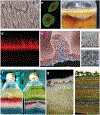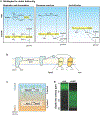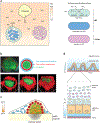Gradients and consequences of heterogeneity in biofilms
- PMID: 35149841
- PMCID: PMC9590228
- DOI: 10.1038/s41579-022-00692-2
Gradients and consequences of heterogeneity in biofilms
Abstract
Historically, appreciation for the roles of resource gradients in biology has fluctuated inversely to the popularity of genetic mechanisms. Nevertheless, in microbiology specifically, widespread recognition of the multicellular lifestyle has recently brought new emphasis to the importance of resource gradients. Most microorganisms grow in assemblages such as biofilms or spatially constrained communities with gradients that influence, and are influenced by, metabolism. In this Review, we discuss examples of gradient formation and physiological differentiation in microbial assemblages growing in diverse settings. We highlight consequences of physiological heterogeneity in microbial assemblages, including division of labour and increased resistance to stress. Our impressions of microbial behaviour in various ecosystems are not complete without complementary maps of the chemical and physical geographies that influence cellular activities. A holistic view, incorporating these geographies and the genetically encoded functions that operate within them, will be essential for understanding microbial assemblages in their many roles and potential applications.
© 2022. Springer Nature Limited.
Figures






References
-
- Caldwell DE & Hirsch P Growth of microorganisms in two-dimensional steady-state diffusion gradients. Can. J. Microbiol 19, 53–58 (1973). - PubMed
-
- Lappin-Scott HM Claude E. Zobell--his life and contributions to biofilm microbiology. in 8th International Symposium on Microbial Ecology 6 (1999).
-
- Babcsányi I, Meite F & Imfeld G Biogeochemical gradients and microbial communities in Winogradsky columns established with polluted wetland sediments. FEMS Microbiol. Ecol 93, (2017). - PubMed
-
- Child CM Patterns and problems of development [by] C.M. Child vol. 820 (The University of Chicago Press, 1941).
Publication types
MeSH terms
Grants and funding
LinkOut - more resources
Full Text Sources

